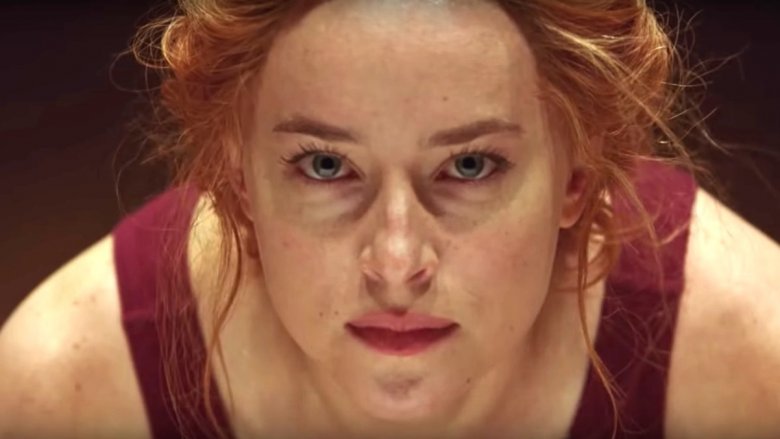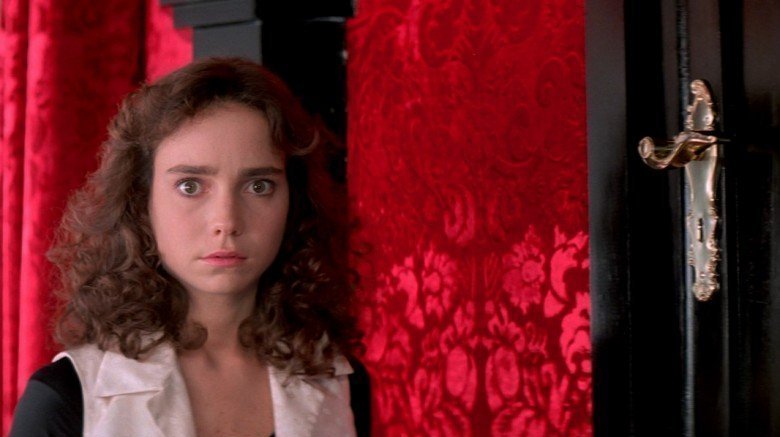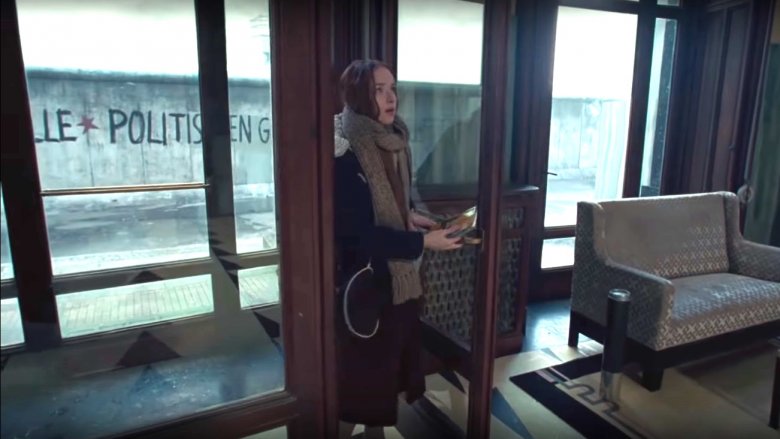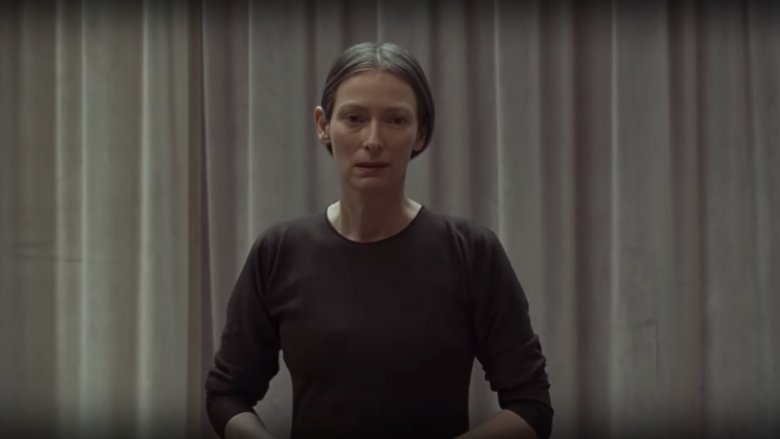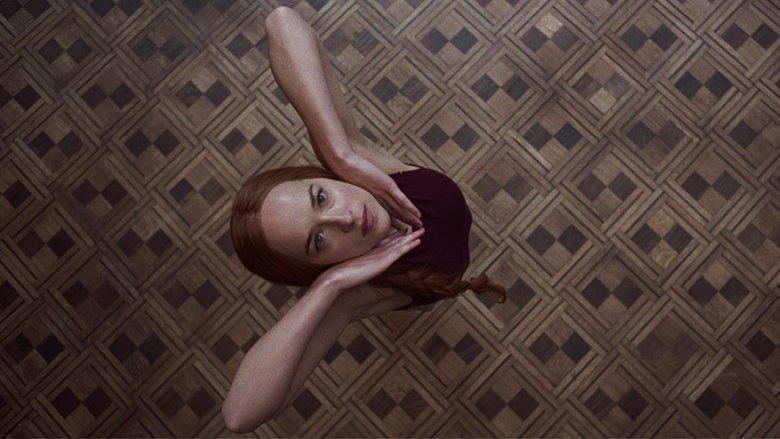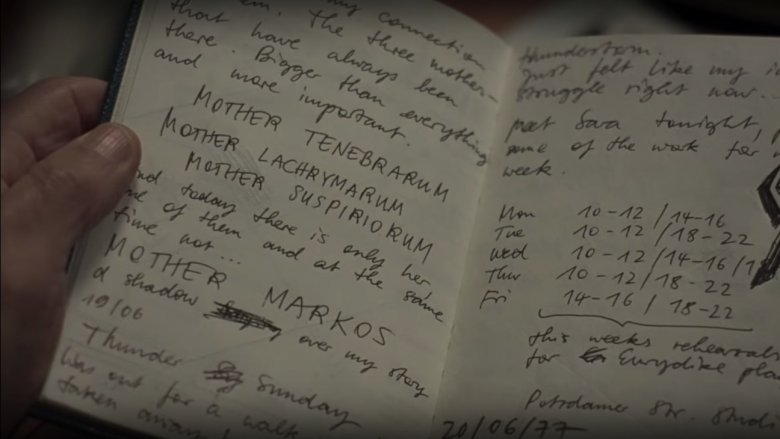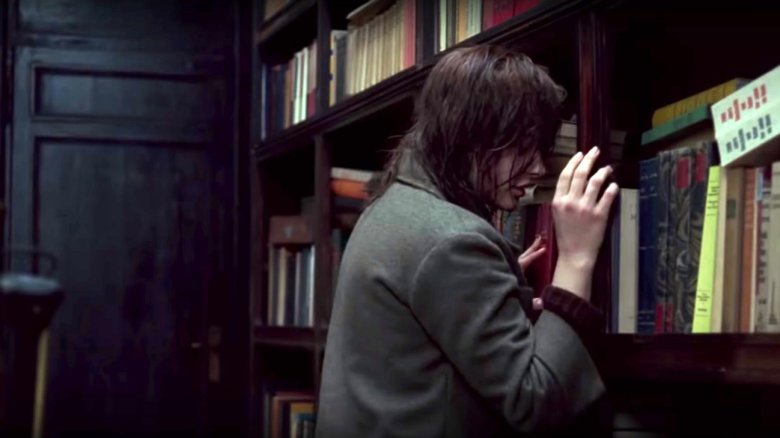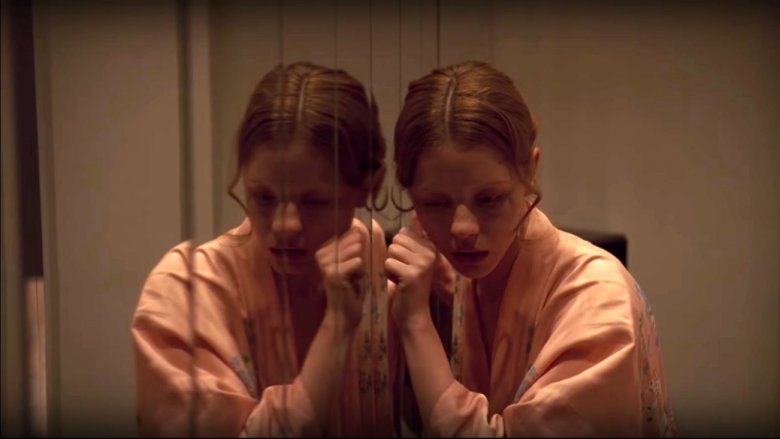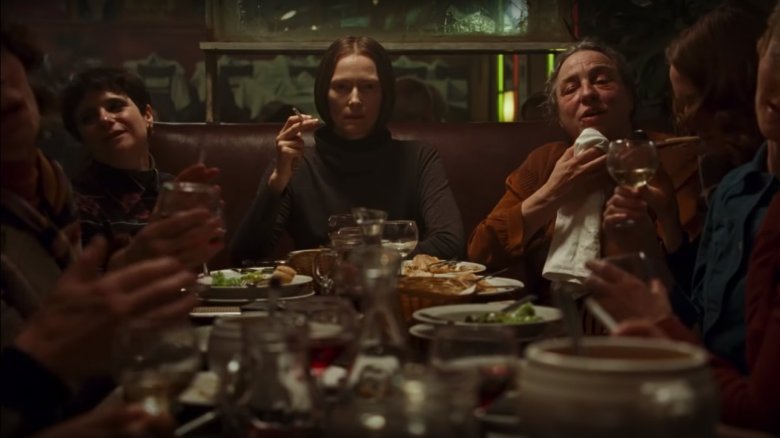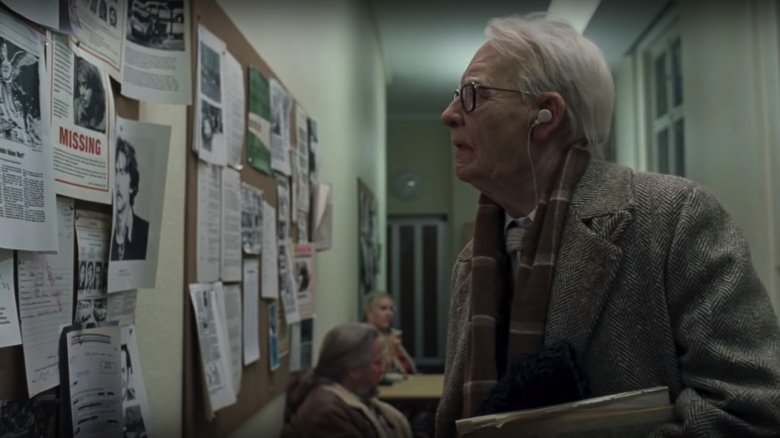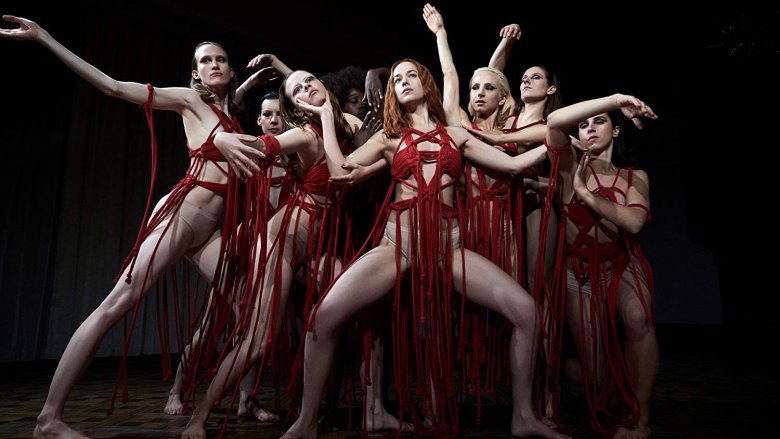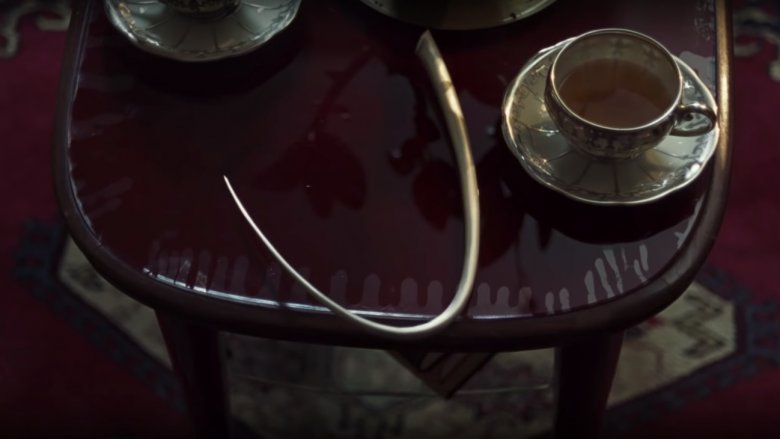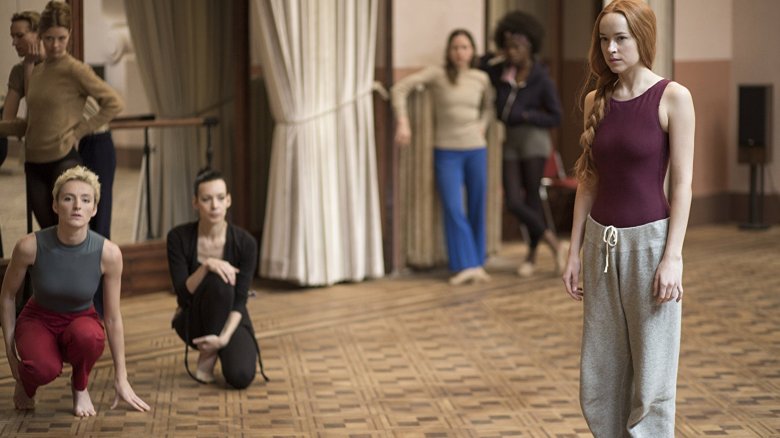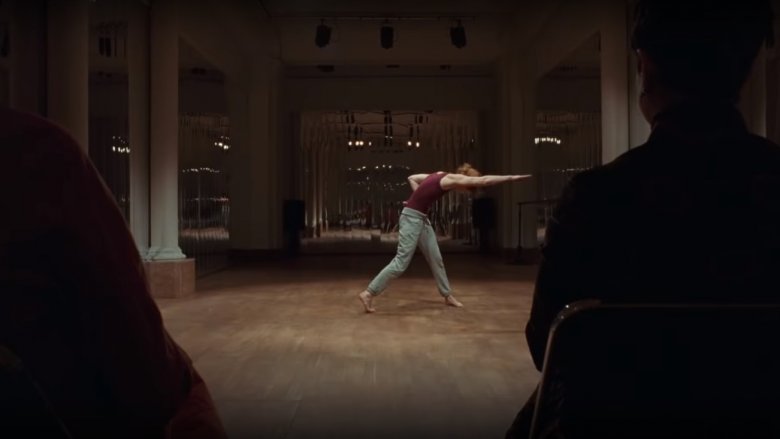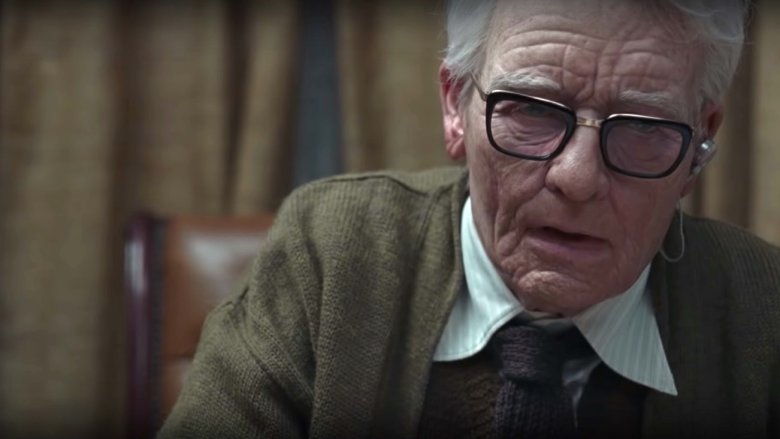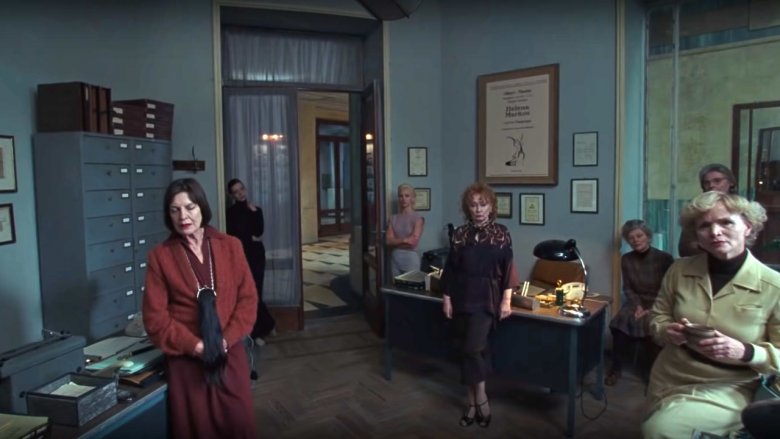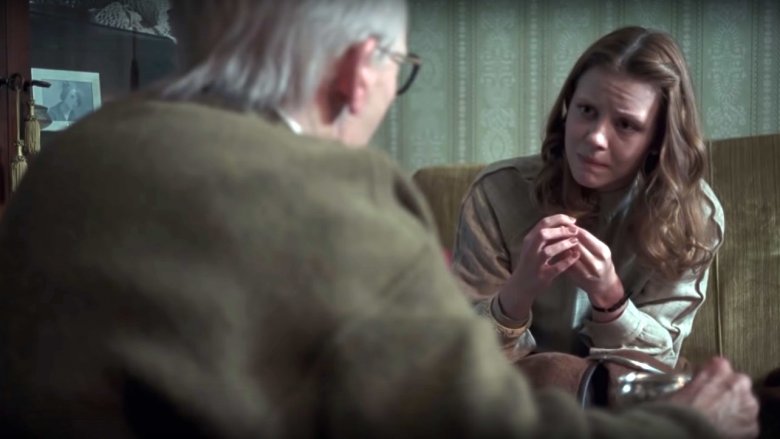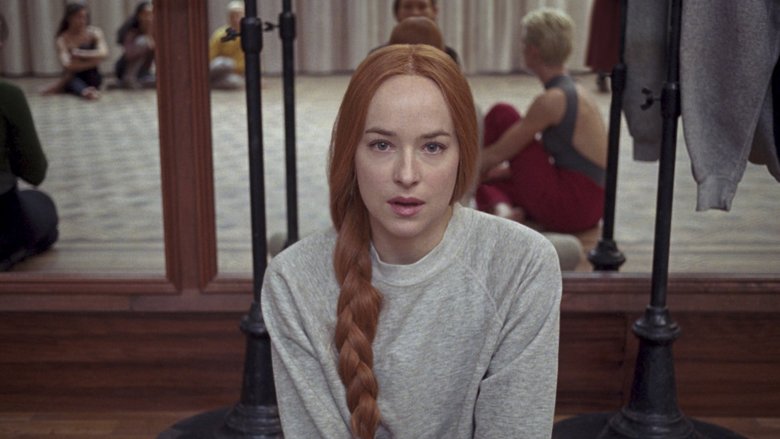The Ending Of Suspiria Explained
So — you went and saw Suspiria. Maybe you even sat through the whole thing! This two-and-a-half hour journey, advertised as a horror film and described as a story in six acts with an epilogue, is pretty definitely not the sort of moviegoing experience that goes down well for everybody. We're sure you have a few questions.
2018's Suspiria, directed by Call Me By Your Name director Luca Guadagnino, is pretty far from your typical horror movie remake. As Variety's Owen Gleiberman described it in a fittingly baffled review, the story has gone from what can be lovingly described as a pretty piece of pop trash in Dario Argento's hands to a highbrow, thematically dense, capital-A "art film" in its second iteration. Usually that works the other way around.
What in the name of Mother Markos happened in this completely insane movie, aside from about a dozen gory fatalities and a swimming pool's worth of spilled blood? As you surely know already, there's a lot going on here. So grab a pen and paper, and let's do our best to diagram out the meaning of the end of Suspiria. (Spoilers ahead, of course.)
A new approach
It might be best to start by comparing the new Suspiria with the original, as there are important differences between the two — particularly regarding the movies' final acts, which completely diverge from each other.
The first Suspiria also focuses on an elite German dance academy visited by an American outsider named Suzy Bannion, played there by actress Jessica Harper. In the original, Suzy ultimately comes to realize that the dance academy is a front for a coven of witches, and burns it to the ground. Argento's movie spends its whole running time leading up to the reveal of an occult society, but that's more or less where Guadagnino's version starts, with Chloë Grace Moretz's Patricia raving manically to Dr. Jozef Klemperer about the conspiracy of witches that has dominated her world and mind.
Guadagnino's version also focuses much more heavily on the aspect of dance, which mostly served as a framing device for a carnival of horrors. It's much more central to the remake's story — as well as the witches' ritual.
Division and fracture
One of the more difficult things to understand about the Suspiria remake is the relevance of its setting. While the original, released in 1977, was set in the German "present" at the time of its debut, Guadagnino and screenwriter David Kajganich have set their so-called "cover version" in 1977 Berlin, turning what was once a contemporary story into a period piece.
Much table-setting is given over to the conflicts and social upheaval of the day, with bombings, kidnappings, and hostage situations serving as the tense backdrop of the more fantastical horror. The most overt historical entity is the stark barrier of the Berlin Wall, which serves as a blunt metaphor for the divide that exists between people in conflict. It's a theme that informs the whole movie, as we are informed that the witches' coven is plagued with infighting over its leadership and future directions, with many simmering rivalries coming to a head in the movie's final ritual.
Rebirth
Around the movie's midpoint, the academy leader Madame Blanc, played by Tilda Swinton, introduces the notion of a new dance centering around the theme of rebirth. (Her proposed title for the piece, Wieder Öffnen, is German for "Open Again").
The idea of reincarnation, or some sort of occult agelessness, is openly alluded to among the instructors of the Helena Markos Dance Company throughout the movie's first two acts. But it's at the midpoint that you begin to see how that theme is going to play out, plot-wise — especially when we get our first glimpse at the deformed claws of Mother Markos, scratching at the edges of her hiding space under the school's floor. While the details aren't made totally explicit, the development gives direction to the story — some kind of dance is going to be conceived, seemingly to bring Markos back to a state of youth. It also seems like the feat will require a costly sacrifice.
A sin smeared over the world
At first, the sympathetic viewer is inclined to relate to the doe-eyed Susie Bannion, played with seeming naivete by Dakota Johnson. Susie's sheltered Mennonite upbringing, her lack of a healthy or loving mother, preternatural dance talent and fearless drive to realize her dreams all make her a relatable protagonist, and you spend most of the movie's runtime scared to death about what's going to happen to her. The witches of the coven clearly regard her as a sacrifice in the making, all but licking their teeth at the idea of offering her up as part of some deadly ritual.
Of course, by the time we get to the end of the movie... well, joke's on them, right? Come to find out, Susie is actually already the reborn ancient witch known as Mother Suspiriorum, destined to be the leader of the company from the movie's very start. She is confident, capable, and imbued with immense power — though perhaps she doesn't know her true identity at first.
Three Mothers
Okay — Mother Who? Good question — and one for Dr. Klemperer to find out.
One of the Suspiria remake's biggest (and most time-consuming) additions to the original narrative is the inclusion of the elderly Dr. Klemperer as a main character, seeking information on the Markos company due to his concern over Patricia, his missing therapy patient. While he initially regards Patricia as a woman suffering from delusions, he soon acknowledges that he has begun to share in this so-called delusion to an extent. He increasingly comes to see Patricia's stories as evidence of a potentially criminal conspiracy, at the least.
As we see from his notes and the diary Patricia left, there is an intricate internal consistency to Patricia's thoughts about the company. Using both of their notes as a guide, Klemperer is able to determine with some accuracy the history of the Markos company. As powerful as its witches are, they are merely descendants of millennia-old figures described as "the Three Mothers." Their names, we learn with him, are Mater Tenebrarum, Mater Lachrymarum, and Mater Suspiriorum — or the Mothers of Darkness, Tears, and Sighs. As the title of the movie suggests, the ending of the movie focuses quite heavily on the latter woman.
In psychic communion
While the movie takes its sweet time getting there, we eventually learn that Patricia's ravings to Klemperer at the story's beginning are actually the perfectly rational viewpoints of a woman who has seen, and been privy to, some nightmarishly witchy business. She alludes to eyes watching her from everywhere, and to having an ability to commune psychically with the instructors at her company.
The audience, like Klemperer, is not initially inclined to believe all of this. But when Susie begins to step in as Patricia's clear replacement in the company, we realize that Patricia was being totally literal. As Mia Goth's Sara observes after her visit to Klemperer, when she briefly sees an instructor watching her in the street, the witches do have eyes everywhere.
As for the telepathy, Blanc first demonstrates this power when she appears to covertly implant nightmares into Susie's mind, dreams which seem to be reflections on past traumas and visions of the future. But by the end of the movie, this mental bond has become a two-way street. As Susie demonstrates in a creepy scene with Madame Blanc, they really can communicate psychically. When we see Susie display this power, we realize that she and Blanc might be on more equal footing than initially thought.
The living dead
Where Patricia resisted the coven, Susie embraces it. In her resistance, Patricia is made to disappear, while in her compliance, Susie ascends. In many ways, she is the left to Susie's right. Where Susie never errs from embracing the darkness of the witches' coven, Patricia rebels against the established order — so much so that the witches are able to present her becoming an extremist left-wing bomber as a plausible cover story for her absence.
As the last acts of the movie reveal, Patricia didn't really disappear from the academy at all. Instead, she's trapped inside it, still alive along with Olga, the woman who Susie's dance physically destroyed earlier in the film.
When Sara descends into the academy's catacombs in the minutes before the company's Volk performance, she succeeds in finally finding Patricia, Olga, and nameless others — all alive, but horrifically disfigured. Thanks to some power of the witches, they are trapped in a state of deathless suspended animation and suffering — a devastating fate which Sara shortly earns for herself as well.
A feast
After the almost-perfect company performance of the Volk dance, the witches of the Markos company are convinced that Susie is ready for... whatever it is that her fate is supposed to be. From the darkening of Susie's eyes in her performance, we the viewers can also sense that something long-simmering is finally coming to a boil.
On the eve of the rebirth ritual for Mother Markos, which we've gathered by now is likely to involve Susie being sacrificed on behalf of the barely-glimpsed witch, the teachers and the students head out to a joyful night at the Paris Café, where they are encouraged to eat and drink to their hearts' content. Blanc and Susie both appear deathly serious during the gathering, but it seems like the other students are enjoying an innocent and fun time — until the very end, when the dancers are seemingly put under some sort of spell. The hypnosis they suffer is subtle, registering in the tiniest expressions of discomfort they display as the witches begin really laying on the affection, singing to them and pawing at their faces in an intoxicated reverie. From that point on, this whole school — and the audience — is on a one-way train to Crazy Town.
The witness
The dancers of the Markos company aren't the only ones summoned up for some dark occult ritual. Earlier, the witches decide to incorporate an old, up-till-now abandoned aspect of the ritual into their next rebirthing attempt, bringing along Dr. Klemperer as an unwilling "witness" to the proceedings. This is not done kindly.
Over the course of the movie, we learn that the somber Klemperer attained his air of loneliness following the disappearance of his wife, Anke Meier, who is implied to have been killed during the Holocaust. Klemperer has spent decades trying to move on from his traumatic separation from Anke — which makes it all the more shocking when she appears to him, seemingly back from the dead, at his country home outside Berlin. (Intriguingly, she's played by Jessica Harper — the original Suspiria's Suzy Bannion.)
The movie plays their reunion so emotionally that you almost don't notice Anke is walking an enraptured Klemperer back from the countryside into West Berlin, beyond the boundary of the Wall, and up to the doors of the Markos academy. As Klemperer realizes where Anke's inexplicably led him, she is suddenly revealed — with a heart-stopping wail — to be a cruel illusion of the witches. Now that all the pieces are in place, the final dance is ready to begin.
Let's dance
All right, folks, this is what you came here for — it's time for the craziest stretch of stuff you'll see in a 2018 horror movie this side of Mandy.
In the movie's sixth and final act, the characters all descend on a hidden chamber inside the academy, where the rebirthing ritual for Mother Markos is supposed to take place. The gang's all there, in a dungeon-like room covered with dead peoples' hair. The dancers, trapped in a trance, are using their naked bodies to form a viscerally disturbing human altar. Klemperer's there, naked and screaming. The witches are there. Also in attendance is the guest of honor — Mother Markos herself, utterly hideous, looking to all the world like a more squat, even grosser Jabba the Hutt. She also wears sunglasses indoors and at night, so you know she's a diva who means serious business. (She is also, if you couldn't tell, played by Tilda Swinton under heavy prosthetics.)
It's happening
This scene is the first time in the movie that we get a full-body glimpse of Mother Markos, and boy oh boy does she look nasty. Her bonkers body has problems that go far beyond age or simple deformity — this is a dramatic degree of corruption. She appears to have extra limbs hanging off that quite simply aren't supposed to be there.
All throughout the movie, Mother Markos is spoken of as though she's just barely made it through a botched attempt at rebirth. The last effort, we are told, ended poorly, with Markos left essentially on death's door.
In this scene, looking at her in the flesh, we can sort of see what this ritual going wrong might look like. With her extra limbs and impossible-looking proportions, it's as though she's partially fused with another body. She was almost reborn, but the ritual didn't work. Now, as Susie enters the room with full confidence, Markos and her supportive allies in the coven believe the time for her reincarnation has finally arrived.
Mind went blank
The most striking thing about this sequence (beyond the insane dancing, score, and creepy visuals, of course) is just how utterly terrified Blanc seems to be. For the first time in the movie, Madame Blanc comes off as the weakest-willed person in the room, scared and doubtful of what's about to occur. Her fear — and Susie's shocking self-assurance — help to inform us that something is off about this long before Blanc herself brings it up.
Markos, failing to understand Blanc's hesitance to pursue the ritual, decides to simply kill her longtime rival by psychically opening up her veins in a torrential spray of blood, nearly decapitating her without ever raising a finger.
Of course, we only think Blanc has been killed. So what if she lost most of her neck's connective tissue, as well as oh my goodness so much blood? As we discover in the movie's lengthy epilogue sequence, she's still deathless — just severely handicapped, and mostly unable to move. If the concerned expression on her face we see in our final moments with her is anything to go by, she's not particularly thrilled about it either.
Mama's home
After Blanc's blood is spilled, it seems like Markos' resurrection is at hand. Little does she know, this ceremony isn't for her at all. As a matter of fact, the ritual is the culmination of a power play that's been brewing in the background for the entire movie.
To the horror of Markos, Susie reveals herself to be none other than the revived Mother Suspiriorum — the millennia-old entity who supersedes Mother Markos in the witches' organizational hierarchy. To the shock of every person who's not stuck in some kind of dance trance, Susie — or Suspiriorum — begins to unleash absolute hell on everyone who dared pretend to be her equal, or seize power in her absence.
After all this buildup, Markos is straight-up killed by Suspiriorum, her body exploding in a cloud of gore and viscera. Every witch who supported Markos as a leader of the group is killed, too. Suspiriorum doesn't pull it off herself — instead, she summons the living embodiment of Death itself to insanely murder all of her enemies, soaking every surface of the room in blood.
The rest of the movie is essentially her victory lap as she assumes control of the company. She's not pure evil, either. Beyond allowing the witches who didn't support Markos' leadership to live on with their memories of the ritual expunged, she also allows the deathless Patricia, Sara, and Olga to finally die, their ruined bodies collapsing to the ground in an act of motherly mercy.
Many faces
While we've yet to mention it during this breakdown, you may have noticed that Tilda Swinton plays a third role in the movie beyond Madame Blanc and Mother Markos. Under the assumed name of Lutz Ebersdorf (and again with the use of prosthetics), she also plays Dr. Jozef Klemperer. It's a bravura acting performance for sure, a veritable living triptych. But... why?
The answer depends on what interview you're reading. Swinton has said that the idea of creating a fake actor for her to play was just "for the sheer sake of fun," but there are thematic reasons why the filmmakers may have done things this way. It all goes back to that idea of infighting, division, and inner conflict — the way Germany splits down the middle, the ways the witches fight against each other, and the way Susie becomes Suspiriorum. Multiple identities from one body; many causes in one house.
Swinton is one person playing three characters, serving as her own antagonist from multiple angles. And she's not the only performer to wear two faces in the movie. Shockingly, the horrible Death monster that paints the academy red at the movie's climax is played by the same actress who portrayed Susie's dying birth mother. Grab a psychology textbook and go figure that one out, why don't you.
A final kindness
One of the movie's funniest moments comes when Klemperer is allowed to leave the academy after his duties as a "witness" are all wrapped up. Shell-shocked and barely able to walk, he's guided out the front doors by one of the witches, who gently pushes him into the night to the sounds of a lullaby. He walks away from the insanity, and makes his way back home. The end? No — it's time for an extensive epilogue.
After Klemperer returns to his home in the city, he sits in bed in an utter daze, regarding some government papers of his dearly departed Anke — papers certifying her as "Aryan," despite Jewish ancestry, which apparently failed to keep her safe during the Holocaust.
As he sits, Klemperer is visited by a mature, cool and confident Susie, now fully imbued with the spirit of Suspiriorum. But Susie is not there to harm him — instead, she takes pity on Klemperer, showing him a kindness by telling him what she knows of Anke's ultimate fate. She tells him of her capture and final days in a concentration camp, using Anke's most private memories of her relationship with Jozef to prove she is telling the truth — a truth the doctor weeps to hear about. After providing him the closure he has sought for decades, Susie then expunges the memories of the horrors he witnessed, essentially setting him free.
Suspirium
The movie ends with an ambiguous shot back at Klemperer's country home, where a heart in the exterior wall was once carved, with Anke and Jozef's initials inside.
The mark is still there at the movie's end, divided in the middle by the corner of the building, making the "A" face one direction while the "J" subtly faces another, with a line separating them. They made the mark when they were young and still together, but the movie closes in the modern day, long after 1977, with new residents milling about the property.
It's a confusing final shot, unless you consider the themes of division that have informed the whole movie up to this point. Anke and Jozef's names are physically divided by the wall's sharp corner, and yet they are encircled in the same heart, bound by love. Years after their deaths, that mark is still there, etched among people who have little knowledge of its significance.
As with a lot of stuff going on in Suspiria, it's a big fat metaphor, man. The property may be full and vibrant, hosting new inhabitants, but the house is still marred by past division — and we can see the evidence, even though the people who suffered from that division are long gone. What does any of this have to do with the otherworldly power of dance? Your guess is as good as ours.
The post-credits scene
Yeah, we're not done. Did you know there was a post-credits scene to this 152-minute motion picture?
While Suspiria does continue beyond its credits reel, the extra scene doesn't do much in the terms of advancing the story. The brief, wordless scene focuses entirely on Susie/Suspiriorum standing in the cold, smiling and gesturing and — according to Guadagnino — "looking forward towards something" in a maddeningly vague manner before walking out of frame.
The meaning of the moment is clearly open to interpretation, which is to say that it doesn't seem to specifically mean anything. But as much as we'd like to send you off by saying "Look, you're on your own here," we do have some ideas.
The original Argento Suspiria was followed up by two sequels: Inferno and The Mother of Tears, each focusing on a different one of the ancient Three Mothers. This gesture feels like a tease about how the academy's witchery will spread into the world outside the frame. But is Guadagnino literally teasing the idea of a straight-up sequel in the vein of Argento's follow-ups? Nothing's been officially announced, and it doesn't feel likely. The most practical explanation is that the shot just intends to send you out of the theater thinking, considering the implications, perhaps exhausted... with heavy sighs.
